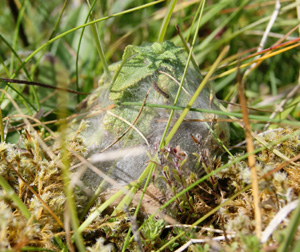This attractive butterfly is the only Irish insect listed on Annex II. It is a colonial butterfly with most individuals remaining in discrete patches of habitat. The adults have a short flight period in May and June and, as they do not wander far from where they emerged, can easily be overlooked. The best time to survey for the species is in September and October when the caterpillars can be found within silken webs on the leaves of the foodplant. Colonies can occur in a wide variety of habitats including sand dunes, calcareous grassland, fens, bogs and upland heaths and grasslands. The presence of its foodplant Devil’s-bit Scabious, Succisa pratensis is an essential habitat component.
The Marsh Fritillary is still widespread in Ireland, but knowledge of its precise distribution is hampered by lack of information on the location of occupied sites and little long-term monitoring. The population of the butterfly fluctuates enormously in a cyclical manner. Colonies need a sufficient area of habitat so that the species can survive natural habitat change and the effect of parasites. Individual sites are thought to exist as part of a network of neighbouring sites that are used periodically as conditions permit. If the habitat patch is large enough, colonies may persist for many years.

Marsh fritillary web (Photo: B. Nelson)
Current research on the Marsh Fritillary is aimed at getting more information on the following aspects:
• Distribution, through surveys of the known range and poorly-covered counties
• Habitat usage. Data are being gathered on the location of webs in relation to vegetation structure, habitat and management practices.
• Population size. The population of Marsh Fritillary can be estimated by counting the number of webs on individual sites.
This research is taking place through funded surveys and collaboratively with the butterfly monitoring scheme organised by the National Biodiversity Data Centre and volunteer butterfly recorders.
